|
Time in Your Pocket
by Bob Brooke
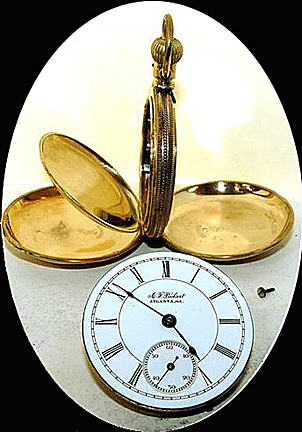 Today,
wristwatches are as ubiquitous as flies on a summer day. But at the turn
of the 20th century they were only a novelty. Back then, most men, and
many women, carried a pocket watch. And unlike many of today’s
wristwatches, these personal timepieces have stood the test of time. For
many, pocket watches have a heart and soul all their own and recapture
the romance of a bygone era. Today,
wristwatches are as ubiquitous as flies on a summer day. But at the turn
of the 20th century they were only a novelty. Back then, most men, and
many women, carried a pocket watch. And unlike many of today’s
wristwatches, these personal timepieces have stood the test of time. For
many, pocket watches have a heart and soul all their own and recapture
the romance of a bygone era.
The concept of the pocket watch began in the 16th century. At that time,
clocks were big and heavy. In fact, most of them resided in the towers
of churches and cathedrals and had huge stone weights to power them.
Back then, "pockets" were small bags or pouches, used to carry
valuables, that hung from a person's belt.
Portable Clocks---The Forerunners of Pocket Watches
German locksmith Peter Henlein from Nuremburg was the first to invent a
portable clock, the forerunner of the pocket watch, during the first
decade of the 16th century. Henlein’s invention of a spring-driven
mechanism made the personal timepiece possible. Spiral springs could be
wound and uncoiled to move the hour hand of the clock. Although
Henlein’s invention was a giant leap forward from hanging weights, it
was highly inaccurate because coiled springs don't unwind at a constant
speed. But having a timepiece people could or wear on a chain, even if
it was off by an hour or so, was a great improvement.
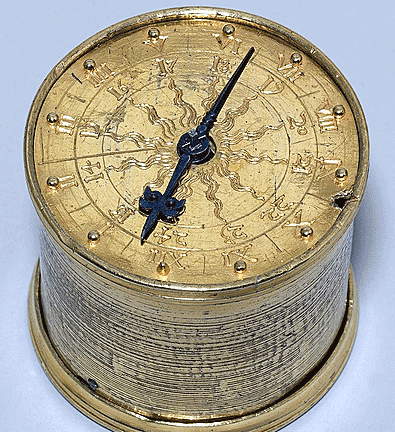 However,
his portable clocks were heavy drum-shaped brass boxes, typically four
or five inches wide and abut three inches thick and would take up much
of a person's pocket or pouch space. By that time the use of belt
pouches was also beginning to change. Pickpockets could easily snatch a
pouch worn outside a person's clothing. Cautious people began to hide
their pocket clock inside their clothing. But wearing a bulky clock
inside your clothing would not only be uncomfortable, but inconvenient.
So people solved this problem by wearing their clock suspended on a cord
or chain around their necks. However,
his portable clocks were heavy drum-shaped brass boxes, typically four
or five inches wide and abut three inches thick and would take up much
of a person's pocket or pouch space. By that time the use of belt
pouches was also beginning to change. Pickpockets could easily snatch a
pouch worn outside a person's clothing. Cautious people began to hide
their pocket clock inside their clothing. But wearing a bulky clock
inside your clothing would not only be uncomfortable, but inconvenient.
So people solved this problem by wearing their clock suspended on a cord
or chain around their necks.
By 1653, tailors had begun sewing small pockets called "fobs," from the
German word fuppe, into the waistband of breeches, in which to carry a
watch, money, or other valuables. The fob, which means "to cheat or
misrepresent, "was meant to cheat any would-be thief of easily removing
a person's valuables. Another change occurred on October 7, 1666 when
King Charles II of England issued a Royal Proclamation which said that
men were to wear coat and a vest instead of a doublet and cloak.
At the end of the 18th Century, improvements in watch-making resulted in
watches that were much thinner and more rounded. Tailors sewed smaller
fob pockets into vests so that people could carry a watch attached to a
chain.
Early Pocket Watches
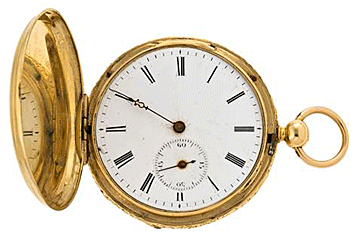 Early
pocket watches only had an hour hand. The dial wasn’t covered with
glass, but usually had a hinged brass cover, often decoratively pierced
with grillwork so the time could be read without opening. Watchmakers
created movements of iron or steel, held together with tapered pins and
wedges, until after 1550 when screws appeared. Many of the movements
included striking or alarm mechanisms. The shape of the watches soon
evolved into a rounded form called Nuremberg eggs. And even later in the
century a trend for unusually shaped watches, shaped like books,
animals, fruit, stars, flowers, insects, crosses, and even skulls,
became popular. Beginning in 1610, a glass crystal covered the watch
dials. To wind and set the watch, the owner opened the back and fitted a
key to a square arbor and turned it. Early
pocket watches only had an hour hand. The dial wasn’t covered with
glass, but usually had a hinged brass cover, often decoratively pierced
with grillwork so the time could be read without opening. Watchmakers
created movements of iron or steel, held together with tapered pins and
wedges, until after 1550 when screws appeared. Many of the movements
included striking or alarm mechanisms. The shape of the watches soon
evolved into a rounded form called Nuremberg eggs. And even later in the
century a trend for unusually shaped watches, shaped like books,
animals, fruit, stars, flowers, insects, crosses, and even skulls,
became popular. Beginning in 1610, a glass crystal covered the watch
dials. To wind and set the watch, the owner opened the back and fitted a
key to a square arbor and turned it.
Early watchmakers, many of whom were either blacksmiths or locksmiths,
made the first watches from steel. Eventually locksmiths dominated
watchmaking as watches grew smaller and silver and gold replaced steel.
At this time pocket watches were typically four or five inches wide and
about three inches thick.
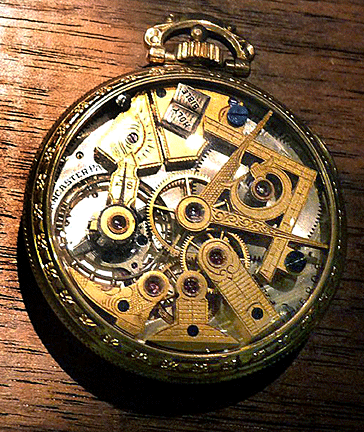 The
first solution to uneven unwinding came when watchmakers realized the
spring uncoiled at a more constant pace when it was not wound tightly.
Various means of preventing this were invented: the stackfreed was a cam
with an additional spring that compensated for the main spring's changes
in speed, and the fusee was a stop that prevented the spring from being
wound too tightly. It was usually made of stiff hog bristle. The
first solution to uneven unwinding came when watchmakers realized the
spring uncoiled at a more constant pace when it was not wound tightly.
Various means of preventing this were invented: the stackfreed was a cam
with an additional spring that compensated for the main spring's changes
in speed, and the fusee was a stop that prevented the spring from being
wound too tightly. It was usually made of stiff hog bristle.
In 1675 several watchmakers discovered that a spiral spring attached to
the balance greatly increased accuracy. Suddenly, watches reflected the
correct time within minutes rather than being off by close to an hour.
Until this time, watches had to be wound twice a day. A fourth wheel
added to the movement decreased the winding required to once per day.
Less than 100 years later, watchmakers added a hand to measure seconds.
As years passed, people wanted calendars to mark the day, date and
month, phases of the moon, as well as alarms, chimes and music.
Early pocket watches had no covering to protect the face or the hour
hand. In the 18th century English watchmakers began creating gold and
silver cases to slide the watch to protect it. The manufacturer's name
or mark is usually found on this case. If it doesn't match the name on
the watch, then the pair case is not the original, but a replacement.
Watchmakers added glass crystals to protect the dial around 1610 but
because they were translucent, people still had to remove them to read
the time.
Until the second half of the 18th century, watches were luxury items,
English newspapers included advertisements offering rewards of between
one and five guineas merely for information that might lead to the
recovery of stolen watches. By the end of the 18th century, however,
pocket watches were becoming more common.
It's What's on the Inside That Counts
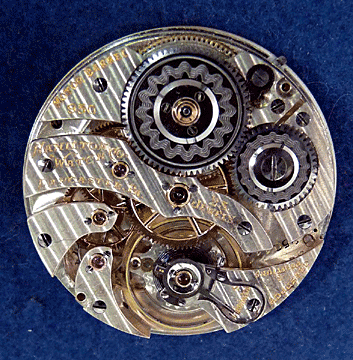 English
watchmakers added jewels, usually second-rate gemstones in the 18th
century as bearings in the watches to prevent friction and wear between
metal parts. However, watchmakers from other countries didn’t adopt "jeweling"
for nearly another hundred years. Today, the number of jewels a watch
has is a sign of its quality and durability. Most pocket watches have
between 7 and 21 jewels. English
watchmakers added jewels, usually second-rate gemstones in the 18th
century as bearings in the watches to prevent friction and wear between
metal parts. However, watchmakers from other countries didn’t adopt "jeweling"
for nearly another hundred years. Today, the number of jewels a watch
has is a sign of its quality and durability. Most pocket watches have
between 7 and 21 jewels.
One of the most important parts of a pocket watch is the escapement. Up
to the 1720s, almost all watch movements employed verge escapements.
This type of escapement involved a high degree of friction and didn’t
include any kind of jeweling to protect the contacting surfaces from
wear. As a result, a verge watch could rarely achieve any high standard
of accuracy. The first widely used improvement was the cylinder
escapement, developed by the Abbé de Hautefeuille early in the 18th
century and applied by the English watchmaker George Graham. Then,
towards the end of the 18th century, the lever escapement, invented by
Thomas Mudge in 1759, was put into limited production by a handful of
makers including Josiah Emery and Abraham-Louis Breguet. With this, a
domestic watch could keep time to within a minute a day. Lever watches
became common after about 1820, and this type is still used in most
mechanical watches today.
In 1857 the American Watch Company in Waltham, Massachusetts introduced
the Waltham Model 57, the first pocket watch to use interchangeable
parts. This cut the cost of manufacture and repair.
Pocket Watch Cases
Pocket watches come in either of two types of cases—hunting or
open-faced.
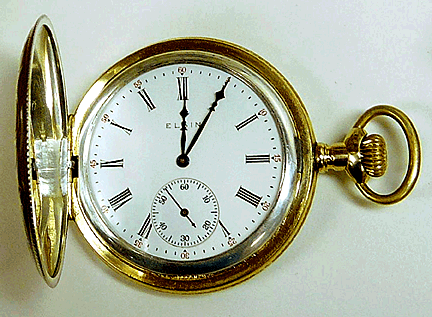 Hunting
case watches, popular during the 19th century, have a spring-hinged
circular metal lid or cover, that closes over the watch-dial and
crystal, protecting them from dust, scratches and other damage or
debris, and opens when the owner pushes a button. Most antique
hunter-case watches have the lid-hinges at the 9 o'clock position and
the stem and crown of the watch at the 3 o'clock position. By 1900, the
open face watch took over and hunting case watches became less
commonplace. Watchmakers made cases of silver and gold. Many were
gold-filled, with two thin sheets of gold on the outside around a
thicker layer of brass. They also used a variety of silver-colored
material, with names like silveride, usually nickel based. Hunting
case watches, popular during the 19th century, have a spring-hinged
circular metal lid or cover, that closes over the watch-dial and
crystal, protecting them from dust, scratches and other damage or
debris, and opens when the owner pushes a button. Most antique
hunter-case watches have the lid-hinges at the 9 o'clock position and
the stem and crown of the watch at the 3 o'clock position. By 1900, the
open face watch took over and hunting case watches became less
commonplace. Watchmakers made cases of silver and gold. Many were
gold-filled, with two thin sheets of gold on the outside around a
thicker layer of brass. They also used a variety of silver-colored
material, with names like silveride, usually nickel based.
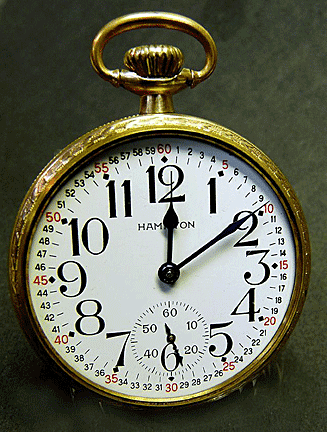 An
open-faced, or Lépine, watch, is one in which the case lacks a metal
cover to protect the crystal. It’s typical for an open-faced watch to
have the pendant located at 12:00 and the sub-second dial located at
6:00. Occasionally, a watch movement intended for a hunting case (with
the winding stem at 3:00 and sub second dial at 6:00) will have an
open-faced case. Such watch is known as a "sidewinder." Alternatively,
such a watch movement may be fitted with a so-called conversion dial,
which relocates the winding stem to 12:00 and the sub-second dial to
3:00. After 1908, watches approved for railroad service were required to
be cased in open-faced cases with the winding stem at 12:00. An
open-faced, or Lépine, watch, is one in which the case lacks a metal
cover to protect the crystal. It’s typical for an open-faced watch to
have the pendant located at 12:00 and the sub-second dial located at
6:00. Occasionally, a watch movement intended for a hunting case (with
the winding stem at 3:00 and sub second dial at 6:00) will have an
open-faced case. Such watch is known as a "sidewinder." Alternatively,
such a watch movement may be fitted with a so-called conversion dial,
which relocates the winding stem to 12:00 and the sub-second dial to
3:00. After 1908, watches approved for railroad service were required to
be cased in open-faced cases with the winding stem at 12:00.
The very first pocket watches, since their creation in the 16th century
up to the third quarter of the 19th century, had key-wind and key-set
movements. A watch key was necessary to wind the watch and to set the
time. This was usually done by opening the caseback and putting the key
over the winding-arbor (which was set over the watch's winding-wheel, to
wind the mainspring) or by putting the key onto the setting-arbor, which
was connected with the minute-wheel and turned the hands. Some watches
of this period had the setting-arbor at the front of the watch, so that
removing the crystal and bezel was necessary to set the time.
Railroad Pocket Watches
Companies such as Elgin, Waltham, and Hamilton invested in pocket watch
design in the late 19th century because railroads needed highly
accurate, precision timepieces so their locomotive engineers could
maintain strict schedules, thus avoiding collisions.
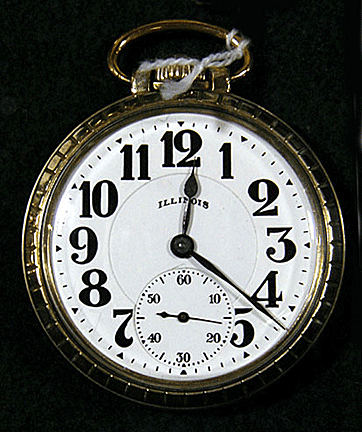 The
rise of railroading during the last half of the 19th century led to the
widespread use of pocket watches. A famous train wreck on the Lake Shore
and Michigan Southern Railway in Kipton, Ohio on April 19, 1891 occurred
because one of the engineers' watches had stopped for four minutes. The
railroad officials commissioned Webb C. Ball as their Chief Time
Inspector, in order to establish precision standards and a reliable
timepiece inspection system for Railroad chronometers. This led to the
adoption in 1893 of stringent standards for pocket watches used in
railroading. These railroad-grade pocket watches, as they became
colloquially known, had to meet the General Railroad Timepiece Standards
adopted in 1893 by almost all railroads. The
rise of railroading during the last half of the 19th century led to the
widespread use of pocket watches. A famous train wreck on the Lake Shore
and Michigan Southern Railway in Kipton, Ohio on April 19, 1891 occurred
because one of the engineers' watches had stopped for four minutes. The
railroad officials commissioned Webb C. Ball as their Chief Time
Inspector, in order to establish precision standards and a reliable
timepiece inspection system for Railroad chronometers. This led to the
adoption in 1893 of stringent standards for pocket watches used in
railroading. These railroad-grade pocket watches, as they became
colloquially known, had to meet the General Railroad Timepiece Standards
adopted in 1893 by almost all railroads.
On April 19, 1891, a train engineer's watch stopped for four minutes and
then started again. This temporary mechanical failure resulted in a
train wreck that caused nine casualties in Kipton, Ohio. A commission
was set up to create new standards for pocket watches used by all
railroads. Standards included having at least 15 jewels (after 1886, the
amount steadily increased afterwards); being accurate within 30 seconds
per week; having a white face, black Arabic numbers each minute
delineated; size 16 or 18; adjusted to five positions; and temperature
compensated. (Canadian RR watches, on the other hand, had Roman numerals
and an inner ring of Arabic numerals from 13-24 for the p.m. hours.) The
rules were sometimes broken so you can still find a RR watch with Roman
numerals. The last two requirements were critical. As the early
watchmakers discovered, not only would cold and heat cause the movement
to slow or speed up, but so did the watch's position. Imagine trying to
carry a watch in one position all the time, especially while working on
a train. Railroad watches had to stand up to constant abuse from the
jarring and swaying of early trains. Engineers were required to have
their watches inspected regularly and to submit a certificate stating
its reliability to supervisors.
Until the start of the 20th century, though, the pocket watch was
predominant and the wristwatch was considered feminine and unmanly. In
men's fashions, pocket watches began to be superseded by wristwatches
around the time of World War I, when officers in the field began to
appreciate that a watch worn on the wrist was more easily accessed than
one kept in a pocket.
Determining the Age of an Antique Pocket Watch
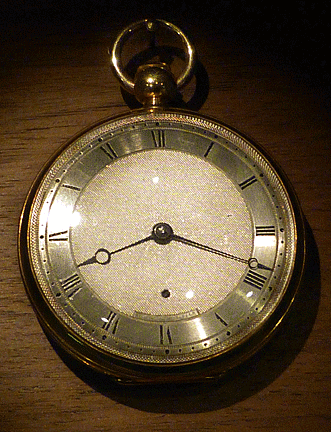 A
collector can determine the age of an antique pocket watch by checking
the manufacturer's serial number in a reference guide. The serial number
on an American watch is on the movement inside the watch, not on the
watch face or the casing. Older English watches have hallmarks that can
be researched to find the manufacturing date. Antique watches made on
the continent in Europe are more difficult to date. Sometimes they have
serial numbers, but often don't. Although patent numbers can be used for
dating. Be aware that the name on a watch's face isn’t necessarily the
name of the manufacturer. Watch manufacturers often printed a company's
name on the dial in return for ordering a specific number. Mail order
and distribution companies did the same thing. A
collector can determine the age of an antique pocket watch by checking
the manufacturer's serial number in a reference guide. The serial number
on an American watch is on the movement inside the watch, not on the
watch face or the casing. Older English watches have hallmarks that can
be researched to find the manufacturing date. Antique watches made on
the continent in Europe are more difficult to date. Sometimes they have
serial numbers, but often don't. Although patent numbers can be used for
dating. Be aware that the name on a watch's face isn’t necessarily the
name of the manufacturer. Watch manufacturers often printed a company's
name on the dial in return for ordering a specific number. Mail order
and distribution companies did the same thing.
Collecting Pocket Watches
Waltham pocket watches are very collectible. But because watch designs
changed often in the early years, they sometimes made only a few of some
models. A good example is the Waltham Model Appleton, a size 20,
18-carat gold watch with a rear key wind that has sold for $10,000.
Because so many were made and in such variety, collectors can buy a
pocket watch in running condition from as low as $100 US up to the
$1000s if you want. Though they don’t appreciate in value much, people
can start a collection with a limited budget.
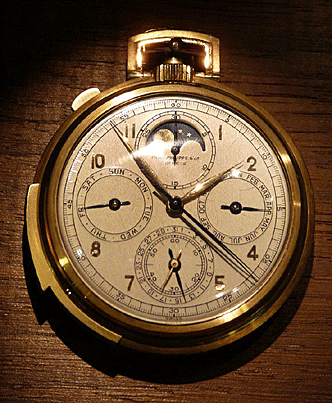 When
purchasing an antique pocket watch, remember that millions were
made—Waltham and Elgin manufactured over 100 million—and there are still
millions in circulation, thus not all pocket watches may have a high
value. Their prices depend on supply and demand. But with pocket
watches, as the demand increases, the supply decreases. When
purchasing an antique pocket watch, remember that millions were
made—Waltham and Elgin manufactured over 100 million—and there are still
millions in circulation, thus not all pocket watches may have a high
value. Their prices depend on supply and demand. But with pocket
watches, as the demand increases, the supply decreases.
Pocket watches are like steam engines or early automobiles. They need
lots of labor intensive service to keep running and not wear themselves
out prematurely. A pocket watch that’s run frequently needs to be
cleaned and lubricated every five years. This can often cost as much or
more than the watch’s value.
From the time of Shakespeare to the end of the Age of Steam the pocket
watch reigned supreme as a portable timekeeper. Its story combines all
the aspects of history, engineering, ingenuity, precision manufacturing,
intrigue, and downright shady dealing into one fascinating whole. What
more could a collector want?
< Back
to Collectibles Archives
Next Article >
|
